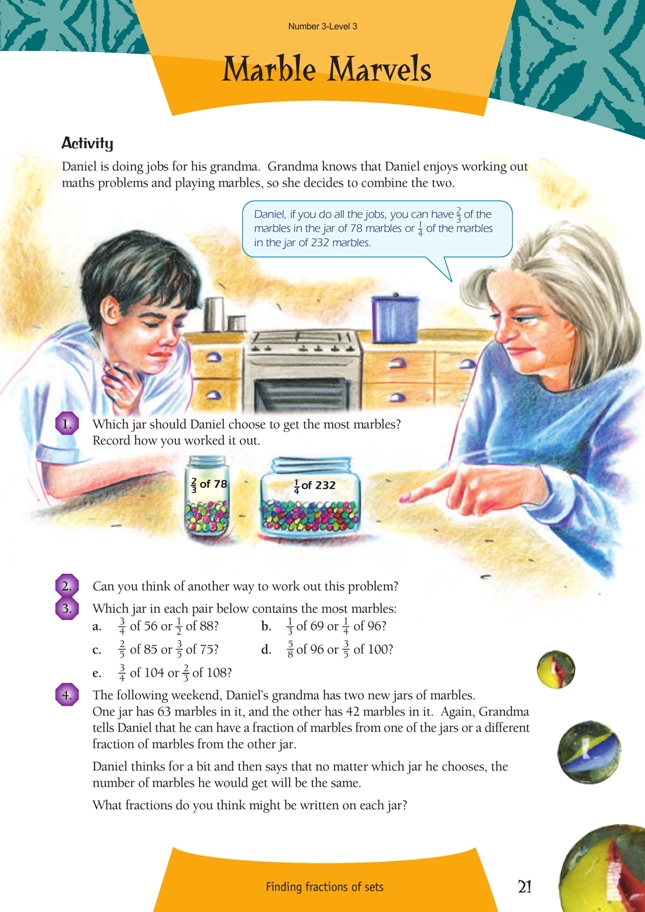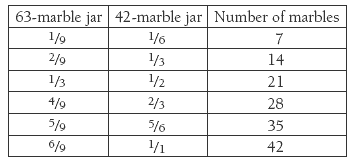This is a level 4 number activity from the Figure It Out series. It relates to Stage 7 of the Number Framework.
A PDF of the student activity is included.
Click on the image to enlarge it. Click again to close. Download PDF (227 KB)
find a fraction of a number
The students will find this activity easier if they have successfully completed the activity on page 20 before they attempt it. For this page, the students need to be able to read and write fractions and understand that fractions are part of a set. They also need to be able to divide and multiply by 2, 3, 4, 5, and 8 and use doubling and halving.
Marble Marvels explores fractions of sets where the number of objects in each set is different. It extends the idea explored on page 20.
Before the students start work on this activity, prompt them with questions such as:
“Here we have a pile of 12 marbles and a pile of 16 marbles. Would it be better to have 1/2 of the pile of 12 or 1/2 of the pile of 16? Why?”
“Would it be better to have 1/3 of 12 or 1/4 of 16? Why?”
“Would it be better to have 3/4 of 12 or 1/2 of 16? Why?”
“What is 1/2 of 66?”
In question 1, some students may misread the 2/3 as 1/3, especially since the comparison is with 1/4. To work out 2/3, the students will need to work out 1/3 of the marbles and subtract that from the whole amount to get the 2/3 amount (or multiply the 1/3 by 2). To find the 1/4 amount, they can simply divide by 4.
Question 2 asks the students to consider whether there are other strategies for working out the problem in question 1. The students’ suggestions should be shared and discussed because some methods may not be as efficient as others.
Question 4 requires the students to reverse the process. Starting with 2 numbers, they have to find a fraction of 1 number that produces the same amount as a fraction of the other. There are a number of possible answers, and a variety of strategies could be used to solve this problem:
• Look for patterns in the numbers: 63 and 42 are both divisible by 7. If we find a multiple of 7, we can then decide the fraction of each. If the multiple were 7, the fraction amounts would be 1/9 of 63 and 1/6 of 42.
• Work backwards: If we had all of the 42 marbles in one jar and 42 of the 63 marbles in the other, what fraction of each are these? The first is one whole (42/42), and 42/63 of the other is 6/9 (or 2/3).
• Trial and improvement: Use a table for the guesses:

Further discussion and investigation
For an interesting discussion, you could ask the students “When can a 1/4 of something be more than 1/2 of something else?”
Answers to Activity
1. He should choose the second jar. The first jar would give him 52 marbles, and the second jar would give him 58 marbles. Methods will vary. For example: 78 ÷ 3 = 26. 26 x 2 = 52 232 ÷ 4 = 58
2. Answers will vary. Other possible methods include:
“Half of 232 is 116. Half of 116 is 58, so a quarter of 232 is 58.”
“A third of 78 is 26. 26 + 26 is 52, so two-thirds of 78 is 52.”
“A quarter of 200 is 50. A quarter of 32 is 8, so a quarter of 232 is 50 + 8 = 58.”
“90 is 12 more than 78. Two-thirds of 90 is 60, and two-thirds of 12 is 8, so two-thirds of 78 is 60 – 8 = 52.”
3. a. The second jar. (It contains 44, and the first one contains 42.)
b. The second jar. (It contains 24, and the first one contains 23.)
c. The second jar. (It contains 45, and the first one contains 34.)
d. Either jar. (Both jars contain 60 marbles.)
e. The first jar. (It contains 78, and the second one contains 72.)
4. Answers will vary. In their simplest forms, possible solutions include:

